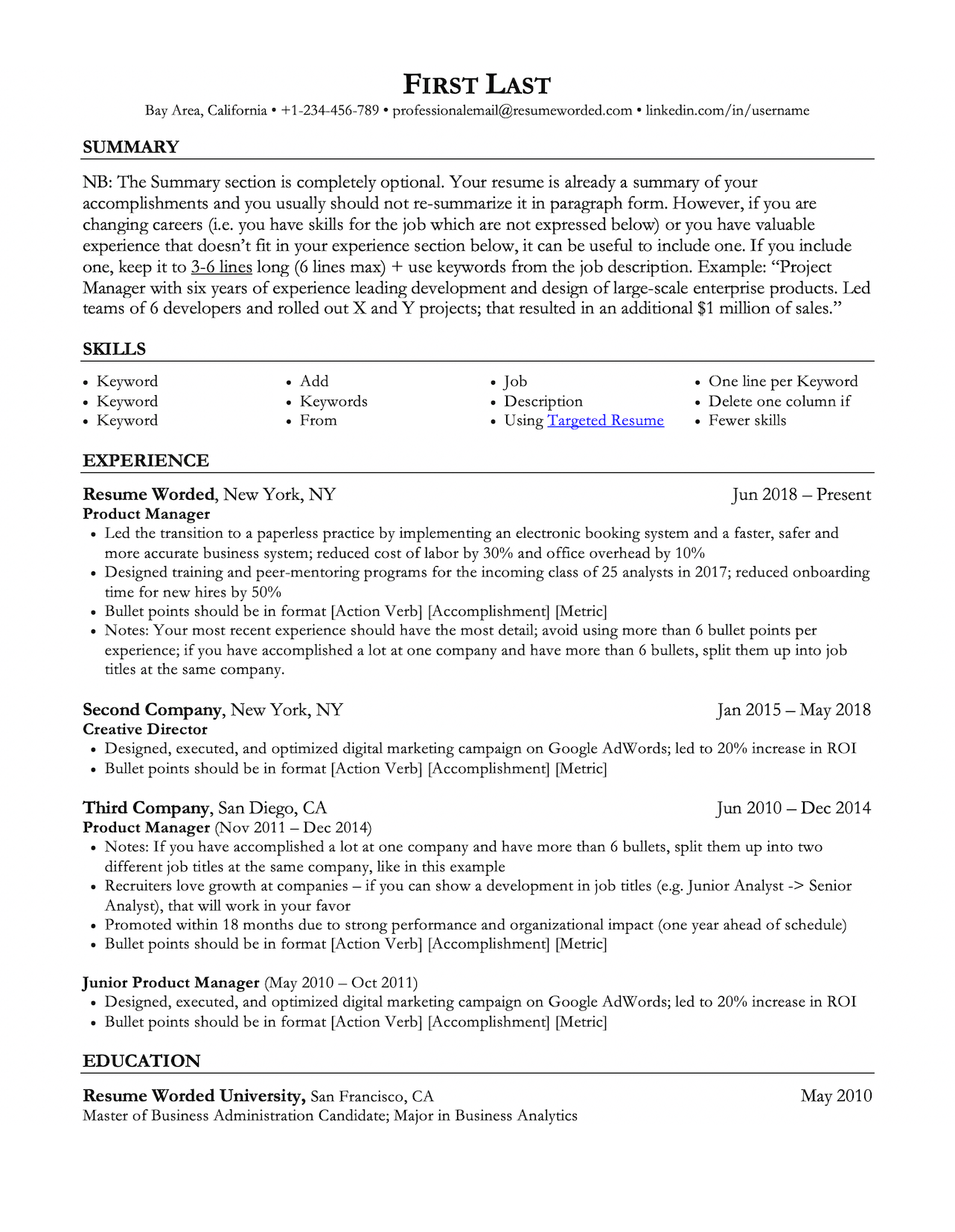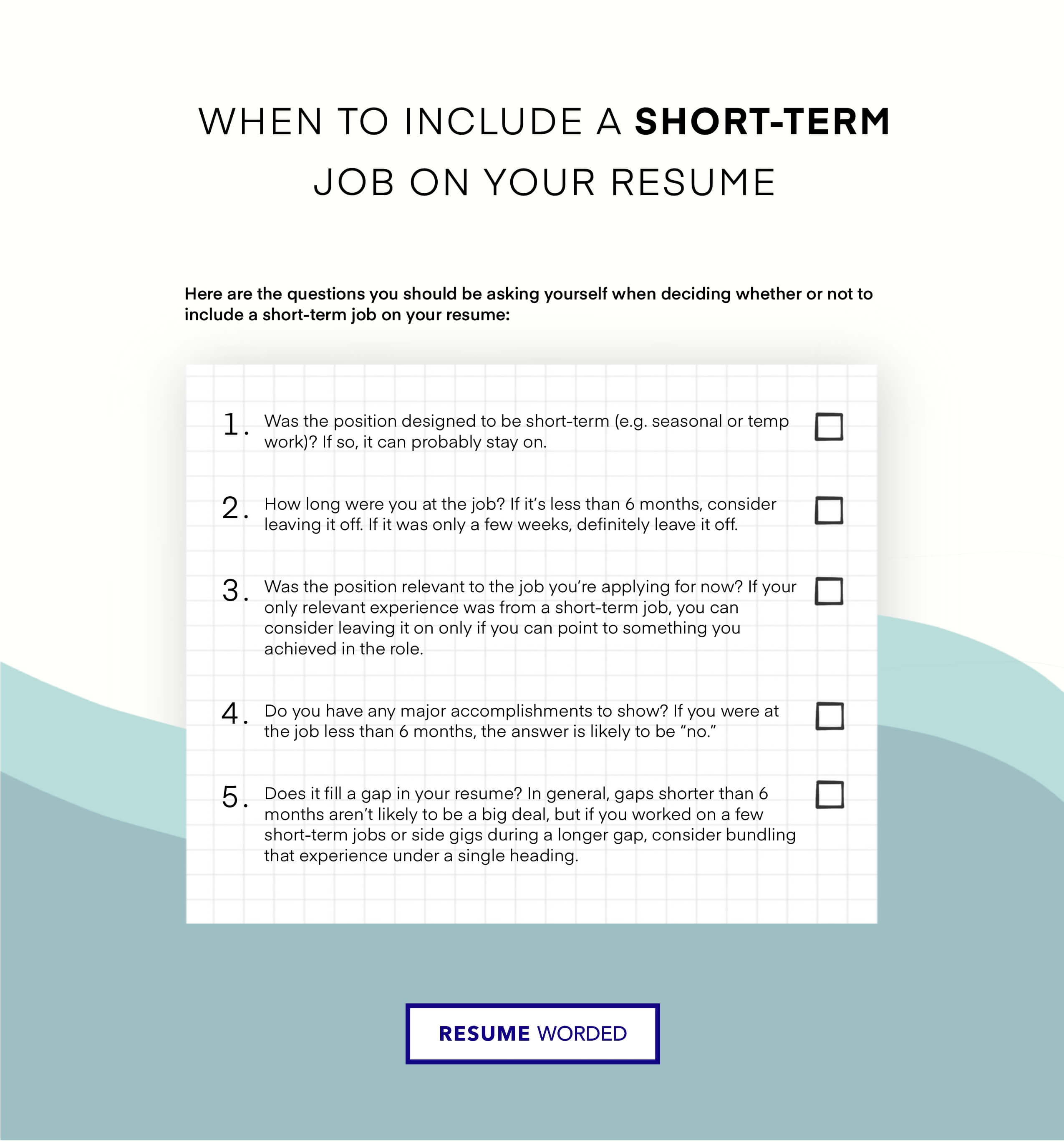The current job market is brutal. You fire off resume after resume, crossing your fingers and hoping that this time, this time, you’ll get an invitation to interview. And then…you don’t. It leaves you feeling frustrated and doubtful that anyone will hire you. If that sounds familiar, you need to know the best resume format for 2024 to maximize your chances.
Quick answer: In 2024, the Reverse Chronological format is the go-to choice for resumes. This format is favored by employers for its clarity, ubiquity, and easy navigation.
In this article, we’ll explore this format, compare it to others, and discuss common resume mistakes to avoid so you land that dream job. Let’s go.
The most popular resume formats in 2024
Stuffy, text-heavy resume formats are outdated and have been replaced by clearly laid out designs to show your employer that you’re right for the job. There are three main types of modern resume formats:
- Reverse Chronological
- Functional
- Hybrid
If none of those sound familiar, don’t worry. I’ll walk you through each one and how you can identify the format that best suits your profession.
Best overall format: Reverse chronological
The reverse chronological format is perfect if you’re going after a new job in your industry. It’s a resume classic, laying out the skills, achievements, and responsibilities you’ve built over the years. It makes an easy map of your career progression for your employer to follow.
How to create a reverse chronological format resume
Start with your most recent employment history and work backward. You don’t want your first impression to be a job you had in the mid-2000s, but including that job history shows your expertise and progression in the field.
The layout and details of your employment history need to be clear, precise, and informative. The list below shows exactly what you need to include:
- Job title: Start with your current job title so employers can quickly see if your career is relevant
- Company: Including the company helps establish your professional reputation and expertise in the field, making a stronger impression on hiring managers.
- Dates of employment: Sharing how long you’ve worked in a position is essential to show that you have dedication but that you also have job growth and ambition.
- Bullet point your achievements, awards, and impact: List and provide examples of the impact you had in each role, any awards or promotions you received, and your achievements - all using quantifiable metrics. Use bullet points to make the information skimmable and easy to digest.
When you’re finished, it should look something like this:
TURTLE CONSERVATION PROJECT MANAGER | The No.1 Turtle Sanctuary
Nov 2021-Current
Initiated and managed the rehabilitation of 200 turtles by operating 50 volunteers and coordinating with twelve turtle charities, increasing the turtle population by 5%.
I don’t know about you, but I'd hire that guy if I were a turtle company.
Best resume for career changers & multifaceted professionals: Hybrid format
The hybrid format is optimal if you have different professions or want to shift into a new career. It combines the functional and the reverse chronological format, showcasing your skills and professional experience.
How to create a hybrid format resume
When creating a hybrid format, start with a section highlighting your skills and qualifications. Beneath your skills, summarize the professional experience that ties to those skills.
Your Skills Section should only include hard skills (like InDesign, Photoshop, Trello, or Python), not soft skills (such as communication or teamwork). If you have a relevant degree or qualification, include it in the Education Section after your skills.
Underneath, in the Experience Section, write how your volunteer work and professional responsibilities relate to your skills. For instance, if you want to be a manager in graphic design, mention that your role as an office administrator included managing the schedules of 20 employees. This demonstrates your ability to organize and effectively run a team.
The essential thing with a hybrid format is demonstrating a connection between your skills and professional background and how they are relevant to the role. This shows the employer that even if you didn’t work in a job directly related to the one you’re applying for, you still have the necessary experience.
Best resume format for recent graduates and career starters: Functional format
Getting a job as soon as you finish college is notoriously tricky. But don’t worry. There’s a resume layout for everyone, and the functional resume format is for you.
The functional format spotlights your skills and accomplishments front and center (rather than your professional experience). It tells your potential boss what you have, not what you’re missing.
For instance, if you want to pursue a career in IT, highlight your volunteer work helping local charities set up cyber protection. It’s relevant experience and shows your skills for the job.
How to create a functional format resume
If you choose a functional format, you want to split your main section into different skill subheadings. For example:
Project Management
Volunteered and managed a six-month turtle conservation project, which included organizing staff and caring for fifty baby turtles before releasing them into the ocean.
Sales
20% increase in customer donations for a turtle charity by networking and communicating with the local neighborhood (I’ve really run with this turtle thing, haven’t I?).
Don’t forget to add your achievements!
Don’t make the mistake of simply listing all the skills you have in a functional resume format. It’s boring to read and doesn’t tell the recruiter how it enables you to do the job.When completing the functional format, ask yourself:
- What did I learn from this skill?
- What were my most significant accomplishments?
- How will it help the company?
The most effective way to highlight your accomplishments is to make sure each bullet point contains an action verb, task, and metric. These elements help to show recruiters the job you did and how effectively you did it. Upload your resume to the tool below for a quick evaluation on your resume’s effectiveness.
2024 resume format trends you need to know
Now that you know the best resume styles, let’s look into how to make yours stand out by including the latest resume trends (yes, resumes can trend!).
Optimize for algorithms: AI is your new audience
Employers increasingly use Applicant Tracking Systems (ATS) to search for the right candidate. The system scans the web looking for keywords that relate to the job. For example, if the recruiter wants a website designer, the ATS might search for ‘WordPress’ or ‘SEO.’
Use AI to your advantage and optimize your resume. Research the jobs you want to apply for and make a note of all the keywords they use in their job description. Add them to your resume so that when an employer uses ATS, you’ll pop up on their screen.
Use the skills search tool below to get a list of hard skills and keywords relevant to the job you're applying for.
Remote work experience is a big plus
When the pandemic hit, most people were forced to work from home, and companies have continued allowing employees to work remotely.
Although working from home seems like a luxury, it also comes with skills that employers seek out. For instance, self-discipline, excellent communication, and time management.
Add those skills to your resume to impress recruiters. For instance, demonstrate how you led a remote team of 20 employees to oversee a turtle conservation project (yes, we’re back at the turtles).
Customize your resume
Employers want to see that you’ve done your research and genuinely care about working for them. Learn how to customize your resume so a company can immediately see you’re a good fit.
Here are some simple ways to tailor your resume to the job:
- Keywords: Include the keywords your employer uses in the job description. For instance, if a requirement is: ‘Experience using WordPress’ (WordPress being the hard skill and keyword), mention that in your resume. E.g., ‘2 years of experience using WordPress.’ That way, they can instantly see that you can do the job.
- Relevant achievements: Your resume is the first thing a recruiter will see, so you need to sell yourself (even if it’s cringey). If a company wants a whiz in Excel, write how you coded a spreadsheet to update work tasks automatically. Don’t be shy! Tell them about your accomplishments. Just make sure it’s relevant to the job.
- Related training: If you’ve done training that applies to the job, add it to your resume. For example, if you want an HR position and recently completed a diversity and inclusion course, put that in! Remember, companies want someone who will make their lives easier. So, include anything that shows them you are that person.
Don’t Forget Social Media
It’s not uncommon for employers to check your social media like LinkedIn and Instagram. A professional and clean-looking account goes a long way and enhances your credibility.
Increase your LinkedIn visibility by posting about the latest news in your profession and sharing inspiring stories. You can also use Instagram to show your passion for the industry, like following a company's account that piques your interest and commenting on the content.
You can still be yourself on social media. Just make sure you delete any pictures of you dancing on the table at a hen party!
Common resume mistakes in 2024
So, you’ve researched professional resume formats and found one that suits you. You’ve also included the current resume trends to stand out.Great work! But now you need to put yourself ahead of the rest by avoiding these common resume mistakes.
- Too much text: Ensure you don’t write out a wall of text. Instead, include headers, white space, and bullet points to break up your resume.
- Too generic: Tailor your resume to suit each company so they can see you’ve done your research and you’re hitting the job description.
- Too much industry jargon: Remove any industry-specific acronyms and software and stick to straightforward language that all recruiters can understand.
- Typos and other errors: If an employer reads 20 great resumes, they’ll look for small mistakes to rule one out. Always proofread your resume to check for grammatical errors. Using a tool like Grammarly is an excellent way to pick up mistakes you may miss.
There’s a resume template for everyone
Whether you're looking for a new job or seeking a change in your career, there’s a resume for you. Remember, these templates aren’t hard and fast rules. You can (and should) personalize them to reach your goals and aspirations.
Choose which one suits you, optimize it so your talent is found, and avoid common mistakes so you can land that job. Good luck!









